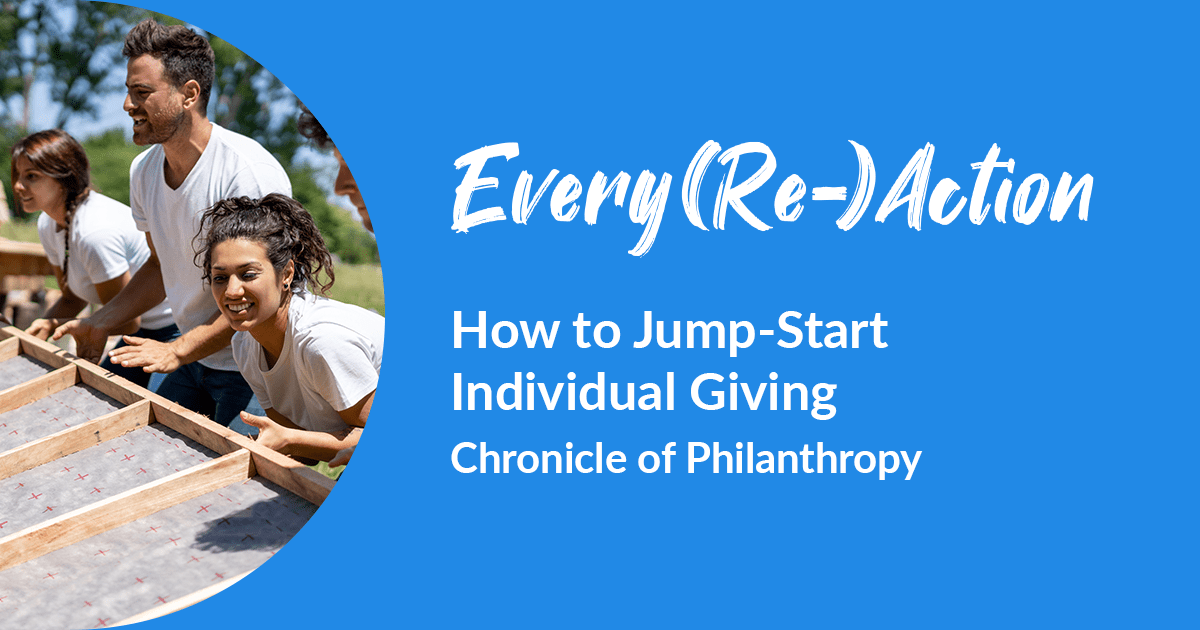Every(Re)Action | How to Jump-Start Individual Giving: Chronicle of Philanthropy

Great news for nonprofits who are planning, testing, and implementing new fundraising strategies now, before end-of-year rolls around: the Chronicle of Philanthropy has released a list of best practices to help organizations jump-start an individual giving program.
The first thing to know when building an individual donor program is that donors aren’t a monolith—your donor pool will likely contain many different unique segments you’ll need to speak to, and your nonprofit will need personalized strategies for reaching different kinds of donors.
Choosing a donor segment to target first can help inform your strategy: if you’d like to prioritize major donors, for example, the Chronicle recommends educating your board about philanthropy and developing an outreach plan together. Starting with grassroots donors, on the other hand, might be a strong choice because they can lead to greater returns in the future: “Such a pool of donors can become a pipeline for major giving, experts say, so it is not necessary to seek big donors at the outset.”
No matter your entry point to individual giving, the Chronicle’s list of best practices can help your nonprofit develop your program. Here are nine of our favorites:
Use social media to broaden your reach.
“Develop messages and materials people will want to share with their networks[…] like a compelling video, infographic, or story.” The M+R 2021 Benchmarks found that “29% of the audience reached by a given [organic Facebook] post was not already following the nonprofit,” so there’s potential for your story to grow and reach audiences beyond your followers list.
Take a targeted approach.
“Use your donor data to understand what drives people’s giving, and group supporters together with similar traits so you can tailor your outreach and start to build relationships.” We agree: successful organizations make a point to unite their supporters’ behavioral and demographic data to send more accurate and targeted messages.
Meet donors where they are.
“If a supporter tells you [they] can’t give right now but wants to stay up-to-date and involved, keep engaging [them.]” This supporter stewarding process is where we’ve seen organizations save time and grow relationships with support from automation.
Test new tactics for engaging donors online.
We’ve said this before, but the holy grail of fundraising is right message, right person, right time. Don’t be afraid to try different digital strategies and measure to see what actually gets results—as the Chronicle says, “now is the time to really take a chance and try something new[.]”
Tap into your trustees’ networks.
The key to this kind of outreach, especially if it involves attending an event, the Chronicle reports, is follow-up: “Thank your new prospective donors immediately[…] and create a smart communications plan to keep them updated on your work.”
Mine your database for potential big donors.
Your supporters’ engagement with you can help you predict their futures as donors—“those who have been giving, volunteering, or attending events consistently” could be strong candidates for major donor stewardship. We’re big fans of evaluating supporter engagement with predictive intelligence, since it can boost your capacity for this kind of analysis without taking up precious staff hours.
Cultivate relationships with prospective donors.
When you’re stewarding a supporter toward making a gift, you want to showcase your efforts—you might “invite them to come see your work in action, meet with one of your leaders, or attend a virtual event.”
Learn what motivates the donor to give.
We’re big fans of using targeting to help you deliver the right message to the right supporters. One facet of strong targeting is identifying and speaking to donors’ reasons for giving to you: “if the donor is passionate about a specific aspect of your mission, [you should] develop a targeted pitch that reflects that interest.”
Give donors the recognition they want.
Not only should you respect donors’ wishes regarding anonymity and public recognition, as the Chronicle recommends, but we know it’s also important to identify the right mix of channels for sending different messages, including donor acknowledgments: some might prefer email, but others might prefer a text.
Our Take
No matter how you start building them out, the most successful individual giving programs are multi-channel and tailored to each supporter. This approach is sophisticated, but it’s worthwhile—and with support from the right platform, you can save valuable staff time and resources while still raising more to fund your mission.


